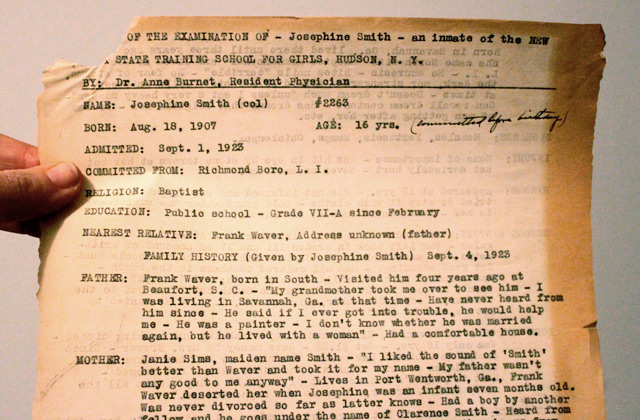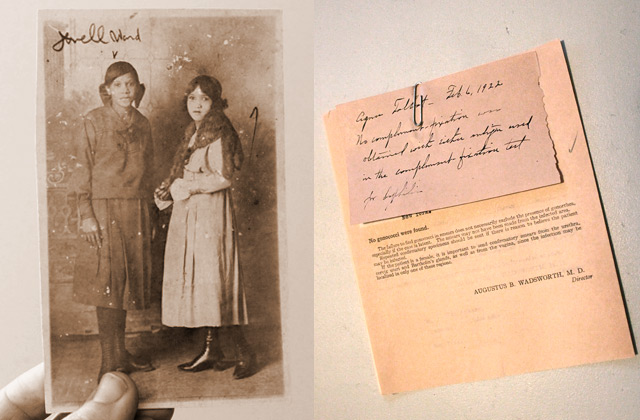
Last July, a box of documents from the New York State Training School for Girls—intake forms, letters, photographs, and other administrative paperwork from the 1920s––was discovered by Lisa Durfee at a Hudson garage sale, on Clinton Street. The papers were stashed in an unmarked gray cardboard box, the size of a hatbox, with no lid or further clues as to how the papers arrived at this sale, so obviously private, partial, and conspicuously removed from the larger paper trail generated by the Training School over its 71 years of operation.
Most of the girls detailed in the papers surely have died (Their birth years range from 1907 to 1908), but there’s no indication in these records what course they took between the time of their residence at the Training School and the end of their lives. The paperwork does offer, in fragment form, a portrait of the student body, expressed through medical and social histories of the intake forms and various girls’ letters home.

From the records, one can detect an institutional obsession with the girls’ physicality, despite the fact that the pseudosciences such as physiognomy and phrenology were arguably passé by the 1920s. Still, intake forms include accounting such as “EARS: Small, lobes attached,” “NOSE: Not typical, but nostrils wide,” “MOUTH: Not typical,” HAIR: Black, kinky, bobbed,” and “FOREHEAD: Medium broad, high.” Today’s reader is left to guess the standards by which a feature was judged “typical” or “not typical.”
What many of the girls shared in common, as laid out in “EXPERIENCE LEADING TO COMMITMENT” is a history of sexual abuse, including instances of rape and molestation. The medical and psychological narratives contained in the forms often conclude with a comment revealing the doctor’s misplaced focus on the girl’s runaway efforts, or on accusations of promiscuity.
Still, the records are not as dismissive as they first appear. Despite their medical syntax and brevity, the records offer an entry point to the girls’ inner emotional worlds.
MENSES: Appeared at 13 yrs. –Was not informed and was frightened and tried to stop it with cloths – Told grandmother who explained it to her – Function is regular and normal.
WORK HISTORY: In Savannah, Ga. Earned money scrubbing and washing dishes – Was only 12 yrs. – Got $1.25.
PERSONAL HISTORY: “Bites nails ‘terrible’—No fear of storms, the dark, nor strangers—Afraid of heights––Talks in sleep at times––Doesn’t dream much ‘unless I eat a very heavy supper’––Can recall dream content––Has dreams that frighten her––Dreams of men getting after her, etc.”
EXPERIENCES LEADING TO COMMITMENT: …Mrs. Anderson’s children struck me with hammers and everything and she didn’t do anything.
It’s worth noting that the resident physician who completed these forms was Dr. Anne Burnet. Women held other high-rank positions at the school, as well.
Within these very reductive documents, one can extract inviolable details and circumstances crucial to constructing a social history of the school. Even if Dr. Burnet’s reports failed to express outright sympathy for the girls, she bore witness.


23 comments
TJacobi says:
Aug 30, 2012
This is an amazing set of documents. Is someone working with them?
Editor says:
Sep 13, 2012
Thanks for your question.
We are hoping to work with these documents more as we move forward. Do you have ideas about working with them?
Carrie says:
Sep 8, 2012
very good reading
Carrie says:
Sep 8, 2012
no thoughts or suggestions as of yet
jennifer says:
Feb 19, 2013
i use to be in hudson in 1972 is any of the staff members from cottage four still around
Emily Hainze says:
Dec 27, 2012
Hello,
I am a PhD student writing my dissertation on women’s prisons during the progressive era, and I’m particularly interested in the daily lives and experiences of African American wayward minors and “incorrigible girls” during this period (my research has focused mainly on New York State so far). I would LOVE to talk more about these records and if possible, come see them. Many thanks!
Editor says:
Dec 28, 2012
Emily,
Thanks for your inquiry. Your work sounds so interesting! We’ll be in touch with you soon to discuss.
Beverly Wallace says:
Feb 9, 2013
Do you know might also be working on such research regarding African American women and girls in the early prison system in other parts of the country?
Editor says:
Feb 15, 2013
Beverly, we have been advised that Dr. Talitha LeFloria, professor at Florida Atlanta University, specializes in the history of the African-American experience and has written a dissertation and forthcoming book on women in Georgia’s convict leasing system in the late 19th/early 20th century.
http://www.fau.edu/history/LeFlouria.php
Email: tleflour@fau.edu
Office Phone:561-297-2334
Jenny Herrick says:
Feb 10, 2013
My grandmother was there when she was 13 in 1930. How can I get more information?
Jenny Herrick. Grandmother was Viola Doutre.
Editor says:
Feb 14, 2013
Hello Jenny, we will follow-up with you via e-mail. Can you be more specific about what kinds of information you are trying to find?
Gillet says:
Feb 14, 2013
These look great, what time period are you asking about for people outside the Northeast? I am trying to do some work on black female criminality in the South (right now mainly looking in the upper South, NC especially) post World War II
Geoff Ward says:
Apr 4, 2013
I am fascinated by this project and would like to help with its development however possible. I have recently published a book entitled The Black Child Savers: Racial Democracy and Juvenile Justice (U. Chicago, 2012), which examines the rise and fall of Jim Crow juvenile Justice, mainly in the U.S. South and urban North from the 1890s to 1970s.
The book’s title refers to the waves of black civic leaders who organized to racially “democratize” the parental state (the state’s authority over children and related institutions). New York city (and NY state institutions) is a main interest as it was a site of particularly effective opposition, thanks in large measure to Judge Jane Bolin (there is a new biography about her). Bolin was the first black woman judge in the U.S. and spent her entire career in the Manhattan juvenile court, and was also prominent in the NAACP.
I have a pretty large collection of documents and images related to the racial history of juvenile justice – compiled over the ten years or so spent writing my book. I am very interested in the Hudson documents you have uncovered and would be happy to share materials through your Prison Public Memory Project.
Editor says:
Apr 13, 2013
Geoff,
Thanks so much for letting us know about your work and new book. We will definitely be including it on our reading lists. We have the new biography of Judge Bolin and read it with great interest. We’d love to talk with you about your collections, the documents we are working with on the Hudson prison, and how we might collaborate. One of us will be in touch soon. Thanks again for writing.
melissa says:
Apr 8, 2013
This site of yous is great. I’m looking for my biological mother. She was at the Training school (okt 67 – april 68 may be also after april) She was pregnant of me at that time. She gave birth to me 9 april 1968. She was then 13 years old. The only thing I know is that het father was negro and het mother Caucasian. Her mother’s grandmother was a full Cherokee Indian. She must have been a nice looking girl with brown eyes and reddish brown hair. I do hope one day to find her. She surrendered me for adoption.
Editor says:
Apr 13, 2013
Melissa,
Thank you for writing to us about your biological mother. We’d like to try and help you find out as about her as possible. We will be in touch with you by e-mail soon.
tara says:
May 22, 2013
what an incredible service you have provided with this website and work. thank you for your profound contribution that clearly has an effect for so many people, and at such a deep level.
Editor says:
May 22, 2013
Thank you so much, Tara. Your taking the time to express your appreciation for our work means alot to us!
Gustav Blom says:
May 28, 2013
Thank you for the work you are performing on this project. There is a name of an young woman listed in the 1920 US Census at the New York State Training School for Girls that I believe to be my grandmother. Can you recommend how one would be able to further research the details behind the listed name to confirm kinship? Any leads you may provide will be appreciated.
Editor says:
May 29, 2013
Thank you for visiting and sharing your question about the young woman you located in the census records who may be your grandmother. As we have mentioned in another post we don’t yet have complete information on what happened to institutional records of girls at the Girls Training School and have been advised that under current New York State policy, all records kept by juvenile institutions except educational records are destroyed after 50 years. On the other hand, we’ve seen information that suggests that the New York State Archives (in Albany, NY) does have some records on these girls that are not educational in nature. And then as you saw in the Bearing Witness post, documents have a way of turning up in unexpected places as happened with those found in the Hudson garage sale by a Hudson resident. From some of the records that have turned up we have seen that they often include home addresses and sometimes names of other family members which in your case might help clarify your search. Do you mind sharing her name and we will keep an eye out for her as we begin to research the NY State Archives and other places? We will be in touch with you shortly via-email to follow-up to get more information on the young woman and to suggest some steps you might take.
Gustav Blom says:
May 30, 2013
Thank you. I will gladly provide you with more details when I’ve received your email.
Heather G says:
Oct 30, 2013
Hello,
I am also searching for a great-grandmother. She was said to give birth at the school in 1941. I have names and dates and lots of clues just no solid documentation.
Has there been any website developed to locate people from the school?
Editor says:
Oct 31, 2013
Hello Heather,
Thank you for writing to us about your great-grandmother and the child she may have had at the school. We don’t know of any website set up specifically to locate people from the school but we are attempting to be helpful to people like yourself who are searching for information on relatives who were or may have been at the Training School and planning a special project for next year to focus just on that. It may be that we will create a new section of our website devoted to that. If you have some ideas about what would be most helpful to people looking for information on their relatives, please do share your thoughts and ideas. In the meantime, we’ll contact you via e-mail to follow up with you about your great-grandmother.